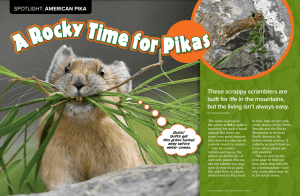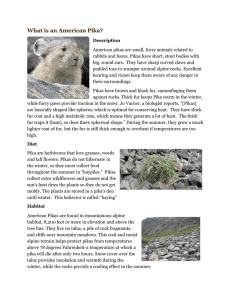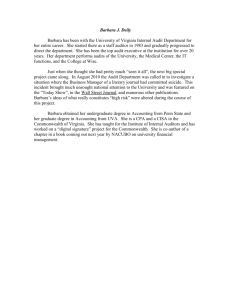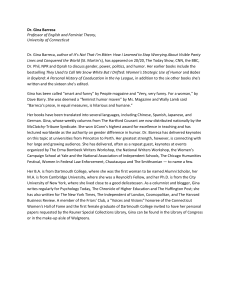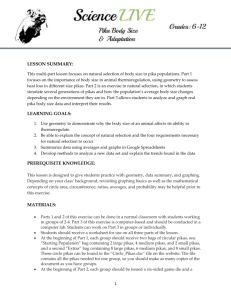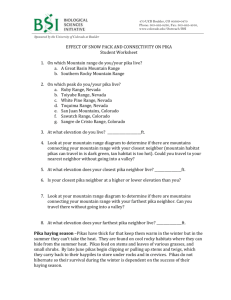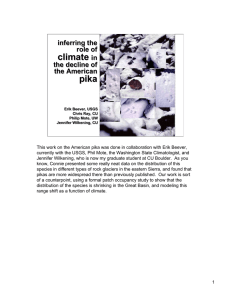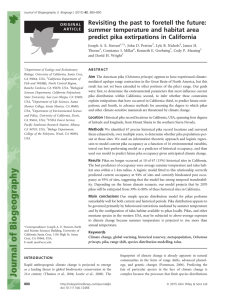Change in Climate - Moore Public Schools
advertisement
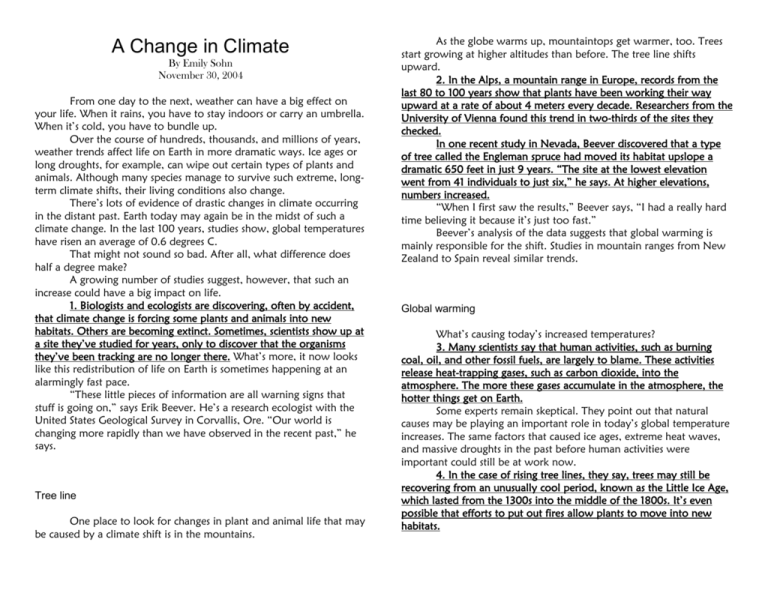
A Change in Climate By Emily Sohn November 30, 2004 From one day to the next, weather can have a big effect on your life. When it rains, you have to stay indoors or carry an umbrella. When it’s cold, you have to bundle up. Over the course of hundreds, thousands, and millions of years, weather trends affect life on Earth in more dramatic ways. Ice ages or long droughts, for example, can wipe out certain types of plants and animals. Although many species manage to survive such extreme, longterm climate shifts, their living conditions also change. There’s lots of evidence of drastic changes in climate occurring in the distant past. Earth today may again be in the midst of such a climate change. In the last 100 years, studies show, global temperatures have risen an average of 0.6 degrees C. That might not sound so bad. After all, what difference does half a degree make? A growing number of studies suggest, however, that such an increase could have a big impact on life. 1. Biologists and ecologists are discovering, often by accident, that climate change is forcing some plants and animals into new habitats. Others are becoming extinct. Sometimes, scientists show up at a site they’ve studied for years, only to discover that the organisms they’ve been tracking are no longer there. What’s more, it now looks like this redistribution of life on Earth is sometimes happening at an alarmingly fast pace. “These little pieces of information are all warning signs that stuff is going on,” says Erik Beever. He’s a research ecologist with the United States Geological Survey in Corvallis, Ore. “Our world is changing more rapidly than we have observed in the recent past,” he says. Tree line One place to look for changes in plant and animal life that may be caused by a climate shift is in the mountains. As the globe warms up, mountaintops get warmer, too. Trees start growing at higher altitudes than before. The tree line shifts upward. 2. In the Alps, a mountain range in Europe, records from the last 80 to 100 years show that plants have been working their way upward at a rate of about 4 meters every decade. Researchers from the University of Vienna found this trend in two-thirds of the sites they checked. In one recent study in Nevada, Beever discovered that a type of tree called the Engleman spruce had moved its habitat upslope a dramatic 650 feet in just 9 years. “The site at the lowest elevation went from 41 individuals to just six,” he says. At higher elevations, numbers increased. “When I first saw the results,” Beever says, “I had a really hard time believing it because it’s just too fast.” Beever’s analysis of the data suggests that global warming is mainly responsible for the shift. Studies in mountain ranges from New Zealand to Spain reveal similar trends. Global warming What’s causing today’s increased temperatures? 3. Many scientists say that human activities, such as burning coal, oil, and other fossil fuels, are largely to blame. These activities release heat-trapping gases, such as carbon dioxide, into the atmosphere. The more these gases accumulate in the atmosphere, the hotter things get on Earth. Some experts remain skeptical. They point out that natural causes may be playing an important role in today’s global temperature increases. The same factors that caused ice ages, extreme heat waves, and massive droughts in the past before human activities were important could still be at work now. 4. In the case of rising tree lines, they say, trees may still be recovering from an unusually cool period, known as the Little Ice Age, which lasted from the 1300s into the middle of the 1800s. It’s even possible that efforts to put out fires allow plants to move into new habitats. Mountain islands 5. Scientists predict that average temperatures may go up another 1.4 to 5.8 degrees in the next 100 years. If it occurs, such a rapid increase wouldn’t give plants and animals much time to adapt to new conditions. Organisms that live on mountains may face the grimmest future. That’s because mountaintops are, in many ways, like islands. They’re isolated clearings that poke up above the tree line. Although it’s too cold for trees to grow at such heights, these alpine environments are ideal habitats for some animals, which have become highly specialized to live there. “A lot of populations are just little frostings on peaks,” says James Brown. Brown is a population ecologist at the University of New Mexico, who was recently quoted in the journal Science. Like animals on islands, these mountaintop creatures have no escape if conditions change. Pick a pika One of the most direct and dramatic demonstrations of the impact of global warming, Beever says, comes from a furry little creature called the pika. 6. Hands down, pikas are among the most adorable animals you’ll ever see in the wild. Though related to rabbits, they look like furry little gerbils. “Even as a male, I can say they’re cute,” Beever says. “They’re pretty nifty little guys.” To see pikas, you have to go high up on a mountain because they can’t survive warm weather. 7. In a famous study in the 1970s, a scientist put pikas in cages at low elevations to see what would happen. Many of the animals died, even in the shade. It was just too hot for them. Their habits make pikas particularly vulnerable to increased temperatures. “They don’t move a lot,” Beever says. 8. “A 1-mile migration for a pika would be a huge, huge, huge deal, and a pretty rare event, as far as we know.” In other words, when conditions change, pikas can’t do much about it. For more than 10 years, Beever has been surveying pika populations in the mountain states of the U.S. West. 9. By the end of 1999, he had confirmed that seven out of 25 populations that he had originally surveyed were gone. More recently, Beever found that two more populations have disappeared. Early warning Not all species are threatened by rising temperatures. Some plants and animals like it hot and dry. Others can move or adapt to get the cold or moisture they need to survive. Pikas are different. “Pikas are an early warning sign,” Beever. “They are very clearly vulnerable to high temperatures.” So, the case of the disappearing pikas is reason enough to wake up and take notice, he says. Something in the weather is changing, and the trends look alarming. But, Beever says, there are things that you can do that may help. Choices you make every day—such as walking instead of going in a car—can add up. By reducing the levels of carbon dioxide and other “greenhouse” gases in the air, we may be able to slow the warming trend. 10. If nothing else, do it for the pikas. The world could always use a little extra cuteness. I bet you don't recycle your family's dryer lint. You probably don't reduce waste by reusing tuna cans as cookie cutters, either. That's okay. The earth is packed full of plenty of areas that could stand a little improving. Take a look in your community — perhaps the pollution needs patrolling, or the sea turtles need saving. There's bound to be at least one environmental cause you find interesting and worthwhile. To celebrate this year's Earth Day, we thought you might enjoy reading about some inspiring young environmentalists. 1. Not only did they realize the powerful effects of a little perseverance and passion, but they also proved to the government, businesses, and even their own critics that kids must be seen and heard. They also got support from the government and businesses to set up five do- it-yourself recycling units in Victoria County. Today, Don't Be Crude has 18 units in seven counties - and protects thousands of acres of groundwater from contamination through improper fluid disposal, says Barbara. 3. In addition, the girls speak to audiences across the nation (some as large as 1,500 people) to encourage young people to get involved in protecting the earth. Sometimes, Barbara says, that involves getting rid of stereotypes. "In Texas, you're labeled a tree hugger if you do something to help the environment – but I think that's just because people aren't very educated about the environment," she says. The team also tries to teach others that there's much more to protecting the planet than recycling cans. "People usually know about recycling," she says. "But they often simply don't realize how much more they could be doing." Barbara: Putting used oil in its place Amir: Reducing school-bus pollution When Barbara Brown of Victoria, Texas, was 11, her friend Kate noticed her father pouring used motor oil on a fencepost to kill weeds. "The weeds did die, but we wanted to know: What happened to the oil?" says Barbara, who is now 17. 2. What Barbara and her friends Kate Klinkerman and Lacy Jones found out was that the toxic oil seeped into the soil and eventually into the water supply. "What we were doing on our land was possibly contaminating our own water," Barbara says. So the trio set out to clean up their own backyards - literally. "We knew that we were just sixth-graders, but that didn't stop us from doing what we believe is right," Barbara says. In 1998, they formed the program Don't Be Crude, and began educating their community about the dangers of using motor fluids as weed and insect killers. (This is a common practice in rural areas like Victoria, especially since many folks live far from carmaintenance locations, which recycle used oil.) In December 2001, Amir Nadav was in his junior year of high school when he decided he wanted to do something more to help the environment. So he wandered into a local Sierra Club meeting. There, they were discussing new reports on the harmful effects of schoolbus idling. "I thought, this is really cool. I ride a school bus, I have friends who ride school buses, so this is an issue that clearly affects me," says the Eagan, Minn., teen. 4. School buses emit diesel exhaust, and when a driver stops the bus but leaves the engine on, it creates a lot of pollution that could be easily avoided, he says. So Amir and two friends wrote a petition calling for reduced idling and increased maintenance inspections (a well- maintained vehicle pollutes less). Then they told fellow classmates about their petition - and to their surprise, they got 500 signatures on the first day. Teens tackle pollution in their communities By Sara Steindorf Christian Science Monitor April 22, 2003 5. "I was a really shy person, and I didn't have the guts to just go up and approach people," Amir says. "But I felt really empowered because it was something I really believed in." Buoyed by their success, the petition writers and several Sierra Club members drafted a state bill calling for minimized idling of school buses. Then they testified before the state legislature. When they ran into opposition, Amir and his co- leaders organized a rally of 150 students on the steps of the State Capitol. It was a success. They gained not only media attention, but key support from the Senate majority leader. He had walked down to check out the rally, and was impressed with the students' knowledge of the topic, along with the 1,000 signatures on the petition. Last May, the bill finally became a law. "If you had told me a few days before I attended that Sierra Club meeting what it would amount to, I would've laughed. It's unbelievable what can happen," he says. 6. Another lesson Amir learned is the importance of researching a cause he felt strongly about. "It's easy to go out and say, 'I want cleaner buses,' " he says. "But I had to know stuff like: retrofits are things you can do to engines to minimize pollution. Oxidation catalysts are parts you can add to buses to reduce pollution.... And diesel exhaust accounts for 75 percent of soot emitted from all vehicles," he says. Such knowledge helped him feel empowered, especially in the beginning when people basically told him: "What you do won't matter – you don't even have the right to vote!" he says. This year, the high school senior leads the Sierra Club's antiidling campaign for students. In his free time, he travels the United States helping students get similar laws passed in their states (only about a dozen states already have bans on idling). Gina: Paving roads with trash Three years ago, Gina Gallant was driving with her family in Cash Creek, British Columbia - known locally as "Trash Creek" because of an overflowing landfill site nearby. Suddenly, inspiration struck: Why not use garbage to pave roads? So the 13- year-old from Prince George, British Columbia, who has been inventing since first grade, took on the challenge. Gina, now 15, already had some knowledge of road-building, thanks to a job at the asphalt division of Husky Oil. But she still needed to do a lot of research. 7. Glass and rubber waste, Gina found, had already been tried in roads in the US. The materials hadn't worked well. So she turned to plastic - which takes up a whopping one-third of all landfill space around the world. (Just think of all the milk jugs, laundry-detergent containers, and water bottles that can pile up over time.) "I thought that since both plastic and asphalt are petroleumbased, they might be compatible," Gina says. Bingo. Gina's new paving material, dubbed PAR for PolyAggreRoad, mixes ground-up plastic bottles with stone material and liquid asphalt. To take the product out of the lab and onto the streets, she tracked down companies willing to grind the plastic to her specifications and mix up enough of the compound to pave an actual road. "At first, some of [the companies] didn't take me seriously because they thought, you know, a 13-year-old can't do something like this," Gina says. "But they finally realized I knew what I was talking about." Finally, last October, the mayor allowed her to test PAR on a 160-foot strip of a local road. Now she's just waiting to see how her road holds up through freezes and thaws, and abuse from cars. Engineers already suspect that PAR will be able to withstand more movement without cracking than regular roads, Gina says. "My ultimate goal is for a company to pick up my product," she says, "and to see it go all the way around the world to reduce garbage in landfill sites." Her advice to others? "Believe in yourself and follow your heart, because if you can think of these ideas, you can do them."

